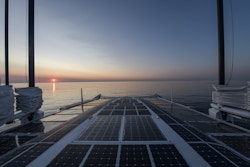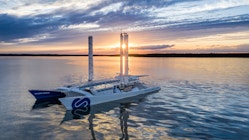Helsinki, Finland
Finland is one of the countries in the world with the best air quality according to the World Health Organization. Due to its population density, the few large cities on the territory but also the largest forest cover in Europe.
Coming from: Stockholm, Sweden
Time of arrival: 1:30 PM

Energy Observer sailing towards Helsinki
The climate emergency
In 2007, the city of Helsinki became aware of the climate emergency. It aims to be carbon neutral by 2050. Its strategy is primarily focused on the energy issue. In Finland’s capital, 96% of emissions are related to energy consumption. Finland has the highest per capital energy consumption in the European Union. A record set by the cold climate that prevails in the country. But also by its geographical configuration which lengthens travel times and by its particularly energy-intensive industrial fabric.
According to the latest report of the International Energy Agency, however, Finland is now one of the industrialized countries with the least dependence on fossil fuels in its energy mix. More than 80% of the electricity produced in Finland is even carbon-free. The government now hopes that renewable energies, led by biomass, will account for at least 50% of the country’s energy supply by 2030. Its new climate policy calls for a complete switch from coal to electricity generation by 2029.

Discovering the oceans is the greatest lesson of humility that nature can offer us. While we are only a tiny part of life on earth, human activity has become the most destructive element of the terrestrial and marine ecosystem #worldoceanday
Innovations in the maritime sector
In parallel, in this country where the maritime sector is important, a first electric car ferry was put into service in early 2018 to connect certain archipelagos in this fragmented territory.
A country engaged in the energy transition and rich in a shipbuilding industry recognized throughout the world for the construction of recreational boats, but also professional ships.
For Energy Observer, a true floating smart-grid, Finland is an important stopover. An opportunity to present its innovations and solutions for the energy transition with its revolutionary energy mix composed of three renewable energy sources (solar, wind, hydro-generation) and a complete chain of decarbonated hydrogen (produced by electrolysis of seawater).

Energy Observer in Helsinki, Finland
It thus emits no CO2, no fine particles and no noise that could disorientate underwater fauna. Decarbonated hydrogen has immense potential for clean mobility.
With two years of sailing and 20,000 km covered, Energy Observer has recently acquired wind propulsion wings, named Oceanwings. Rotating, self-propelled and 100% automated, they will reduce the ship’s energy consumption, accelerate its speed but above all produce energy and hydrogen while sailing.